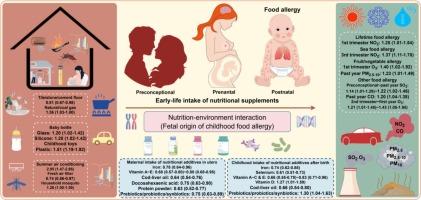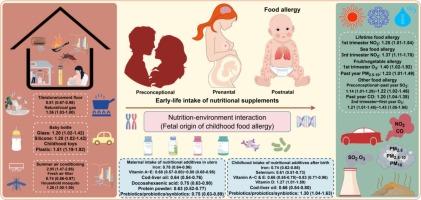幼儿营养添加剂、家庭环境和空气污染与儿童食物过敏的关系:中国多城市母子研究
IF 9.7
1区 环境科学与生态学
Q1 ENVIRONMENTAL SCIENCES
引用次数: 0
摘要
营养补充剂和环境与食物过敏(FA)有关,但很少有研究探讨它们对儿童FA的相互作用。目的探讨儿童早期营养补充剂、家庭环境因素(HEFs)和室外空气污染物(OAP)暴露与儿童FAs的关系及其相互作用。方法:我们从中国5个城市收集了20,730份调查问卷,涵盖了个人特征、健康结果和hef的数据。采用多水平logistic回归模型来确定早期营养补充剂、hef和OAP暴露对儿童FAs的影响。结果儿童FA与母亲孕期铁、维生素A-E、鱼肝油、二十二碳六烯酸(DHA)、蛋白粉、益生元/益生菌/合成菌的摄入量以及儿童期铁、硒、维生素A、B、C、E、鱼肝油的摄入量呈负相关。儿童时期摄入维生素D和益生元/益生菌/合成菌会增加患FA的风险。使用瓷砖/石头/水泥地板,硅橡胶奶瓶和新鲜空气过滤器可以降低FA风险。相反,使用玻璃奶瓶、塑料玩具、夏季使用空调和蚊子会增加患FA的风险。在不同的模型中,FA与妊娠早期NO2暴露呈一致的正相关,而与其他污染物的相关性不一致。母亲和儿童摄入营养补充剂减轻了HEFs和OAP暴露对FA的不利影响,同时放大了保护作用,表明营养-污染相互作用。结论早期营养补充剂、hef和OAP暴露分别或共同影响儿童FA。然而,不能排除由于多次检测而产生假阳性的可能性,在复制之前应谨慎解释本文章由计算机程序翻译,如有差异,请以英文原文为准。


Early-life nutritional additives, household environment, and air pollution in relation to childhood food allergies: A multi-city mother–child study in China
Background
Nutritional supplements and environments have been linked with food allergy (FA), but little research has explored their interactions on children’s FA.
Objectives
To explore the associations between early-life nutritional supplements, household environmental factors (HEFs), and outdoor air pollutant (OAP) exposures, and their interactions on children’s FAs.
Methods
We collected 20,730 surveyed questionnaires from five Chinese cities, covering data on individual characteristics, health outcomes, and HEFs. Multilevel logistic regression models were conducted to establish the impacts of early-life nutritional supplements, HEFs, and OAP exposures on children’s FAs.
Results
Children’s FA was negatively associated with maternal intake of iron, vitamins A-E, cod-liver oil, docosahexaenoic acid (DHA), protein powder, and prebiotic/probiotics/synbiotics during pregnancy, as well as childhood intake of iron, selenium, vitamin A, B, C, E, and cod-liver oil. Childhood intake of vitamin D and prebiotic/probiotics/synbiotics increased FA risk. Using ceramic tile/stone/cement floor, silicone rubber baby bottle, and fresh air filter reduced FA risk. Conversely, using glass baby bottle, plastic toy, air conditioning in summer, and mosquitos increased FA risk. FA was consistently positively associated with NO2 exposure within the first trimester, while not consistently related with other pollutants in different models. Maternal and childhood intake of nutritional supplements mitigated adverse impacts of HEFs and OAP exposure on FA, while amplifying protective effects, indicating a nutrition-pollution interaction.
Conclusions
Early-life nutritional supplements, HEFs, and OAP exposures separately and jointly influence children’s FA. However, the possibility of false positives due to multiple testing cannot be excluded, which should be interpreted with caution pending replication.
求助全文
通过发布文献求助,成功后即可免费获取论文全文。
去求助
来源期刊

Environment International
环境科学-环境科学
CiteScore
21.90
自引率
3.40%
发文量
734
审稿时长
2.8 months
期刊介绍:
Environmental Health publishes manuscripts focusing on critical aspects of environmental and occupational medicine, including studies in toxicology and epidemiology, to illuminate the human health implications of exposure to environmental hazards. The journal adopts an open-access model and practices open peer review.
It caters to scientists and practitioners across all environmental science domains, directly or indirectly impacting human health and well-being. With a commitment to enhancing the prevention of environmentally-related health risks, Environmental Health serves as a public health journal for the community and scientists engaged in matters of public health significance concerning the environment.
 求助内容:
求助内容: 应助结果提醒方式:
应助结果提醒方式:


